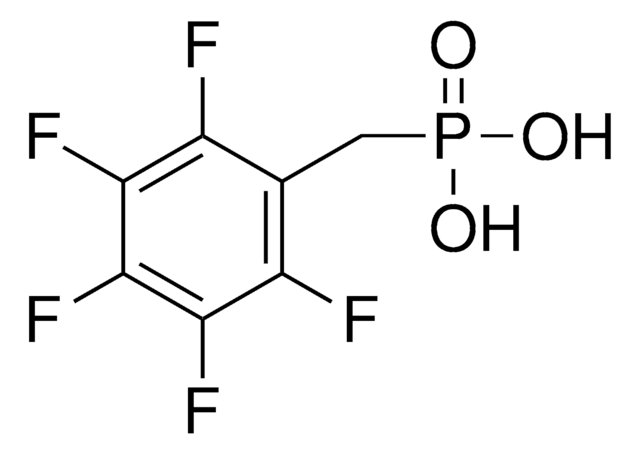All Photos(1)
About This Item
Empirical Formula (Hill Notation):
C66O6NH7
Molecular Weight:
909.76
UNSPSC Code:
12352103
NACRES:
NA.23
Recommended Products
General description
C60 Pyrrolidine tris-acid (CPTA) is a fullerene derivative that has carboxyl functionalized carbon buckyballs. It is majorly used in electrochemical devices as an electron transporting layer (ETL) due to its high energy level and electron mobility. It can be used as an alternative to conventional metal oxide based charge carrying films, through the esterification of a carboxylic acid with hydroxyl groups. Its solubility in water and other polar solvents makes it useful in solution processed devices.
This is a high value compound - minimal loss. It is water soluble fullerene, hence suitable for biological applications. Water-soluble fullerene adduct. Mono-adduct solubility at pH ~13 is about 0.5 mg/ml, giving stable solutions with aggregates in the 20 - 200 nm range. At pH 7.4, solubility is about 0.002 - 0.005 mg/ml.
Application
C60 Pyrrolidine tris-acid may be used as a cathode buffer layer in solar cells. It may be used as a wetting layer in an organic photovoltaics.
CPTA can be used as a cathodic buffer that forms a conductive layer between the active layer and the electrode layer for the fabrication of polymeric solar cells and perovskite based solar cells.
signalword
Warning
hcodes
Hazard Classifications
Eye Irrit. 2 - Skin Irrit. 2 - STOT SE 3
target_organs
Respiratory system
Storage Class
11 - Combustible Solids
wgk_germany
WGK 3
ppe
dust mask type N95 (US), Eyeshields, Gloves
Choose from one of the most recent versions:
Certificates of Analysis (COA)
Lot/Batch Number
Don't see the Right Version?
If you require a particular version, you can look up a specific certificate by the Lot or Batch number.
Already Own This Product?
Find documentation for the products that you have recently purchased in the Document Library.
Customers Also Viewed
Efficient and Hysteresis-Free Perovskite Solar Cells Based on a Solution Processable Polar Fullerene Electron Transport Layer
Wang Y, et al.
Advanced Energy Materials, 7(21), 1701144-1701144 (2017)
Probing ultrafast charge separation at organic donor/acceptor interfaces by a femtosecond electric field meter.
Kaake LG, et al.
Applied Physics Letters, 99(8) (2011)
High performance polymer solar cells with a polar fullerene derivative as the cathode buffer layer.
Li X, et al.
Journal of Material Chemistry A, 1(40), 12413-12416 (2013)
Okuda
Fullerene Science and Technology, 8, 89-94 null
Fullerene nanoparticles exhibit greater retention in freshwater sediment than in model porous media.
Zhang W, et al.
Water Research, 46(9), 2992-3004 (2012)
Articles
Find various photovoltaic and bioscience-based applications of fullerenes.
Optoelectronic Devices Based on Diketopyrrolopyrrole (DPP)-containing Conjugated Small Molecules
Our team of scientists has experience in all areas of research including Life Science, Material Science, Chemical Synthesis, Chromatography, Analytical and many others.
Contact Technical Service![[6,6]-Phenyl C61 butyric acid methyl ester ≥99%](/deepweb/assets/sigmaaldrich/product/structures/359/221/d990c746-0960-4c69-bf76-fe09b193824d/640/d990c746-0960-4c69-bf76-fe09b193824d.png)




![[6,6]-Phenyl C71 butyric acid methyl ester, mixture of isomers 99%](/deepweb/assets/sigmaaldrich/product/structures/716/624/9fb9f2f0-ae99-429f-8d3a-b12267976a4d/640/9fb9f2f0-ae99-429f-8d3a-b12267976a4d.png)

